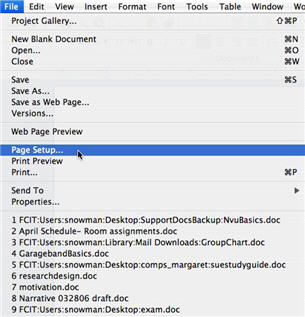

#Word for mac set some pages to portrait and landscape how to
How to make a timeline in PowerPoint automaticallyĪpart from being time-consuming, manually creating a timeline in Word may also get frustrating if you want to apply custom changes or need to update the visuals regularly for important presentations. This should make it easier for your audience to follow the succession of milestones.įinally, to make certain milestones stand out even more, you can also resize them or change their shape using the options in the SmartArt Tools Format tab.Īfter experimenting with several shape and size options, my MS Word timeline looks like this: Next, you can use Drag & Drop to decrease the width of the arrow shape and move the circles a little higher or lower on the timeline to position them closer to their corresponding descriptions. For example, you can change the color of a milestone or of the arrow-shaped band using Shape Fill, and that of the text using Font Color. To customize individual items on the timeline, use the formatting options available in the small window that appears once you right-click on the specific element you want to personalize. In my example, I applied the Intense Effect style, which made the milestone shapes more prominent. Now that your basic timeline is outlined, you can customize its overall look by changing its primary color theme from the Change Colors dropdown menu or by selecting a different style from the SmartArt Styles section.

A better alternative would be for you to expand the graphic box, which will automatically make the texts larger too. Note: Manually increasing the text size for improved readability may ruin the entire layout of your timeline. This is why a maximum of 7 milestones is recommended to make sure that your data remains legible. The more events you add, the more the text size will shrink. To insert extra events or deliverables on your timeline, simply press Enter after an existing milestone label inside the Text Pane. This is why I recommend leaving them as they are. You have the option of manually dragging them closer or farther from one another, but the graphic will get distorted as you add more items. Note: Since Word is not able to automatically calculate time intervals between milestone dates, your milestones will be placed at equal distances on the timeline regardless of the number of days between them. To show a milestone’s date below or above its description, you can insert a line break using Shift + Enter. You’ll find that it makes it much easier to update the default graphic than entering your data directly in the input fields on the timeline.Įnter your milestone dates and descriptions inside the Text Pane - the graphic will be automatically updated. Once Word has generated your basic timeline, open the Text Pane by clicking on whichever of the two areas bordered in the image below. If you want to try out different layouts for your timeline, you can always change the style and colors from the SmartArt Tools Design tab on the ribbon. You have a variety of options to choose from, but for a simple timeline that shows the main milestones of a project, I’d recommend going with the Basic Timeline, which you can see bordered below.

Select the Process category within the window that pops up and pick the graphic type that you want to use for your Word timeline. Select the Insert tab and click on the SmartArt button in the Illustrations section. To do so, go to the Layout tab on the Word ribbon and click on Orientation. Open a new Word document and change the page orientation from Portrait to Landscape, which will make room for more items to be placed on the timeline. On iPad, tap the View Options button , then turn Two Pages on or off.How to make a timeline in Word 1.On iPhone, tap the More button, then turn Two-Page View on or off.You can view facing pages as a two-page spread, or as a single page: In a page layout document, tap the More button, tap Document Setup, then turn on “Left and Right are Different,” located under the Facing Pages switch.Turn on “Left and right pages are different.” In a word-processing document, tap the More button, tap Document Setup, then tap Section.You can set different headers and footers for the left and right facing pages:.In a page layout document, turn on Facing Pages. In a word-processing document, tap Document, then turn on Facing Pages.With the document open, tap the More button, then tap Document Setup.

Use facing pages for layouts for printed books, or for double-sided documents that you intend to print. Documents set up as two-page spreads can have different headers, footers, and section layout objects on left- and right-facing pages. You can set your document up as a two-page spread.


 0 kommentar(er)
0 kommentar(er)
